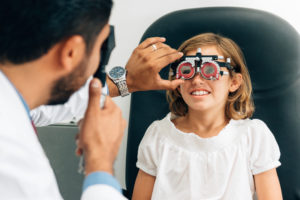February 15, 2023
By Jeffrey Cooper, MS, OD
If you identify and treat problems associated with myopia, you must assess and provide treatment for binocular vision problems. As an eye care professional, you have a choice: treat them or refer them.

Among the most common problems afflicting children and adults are binocular vision issues. We assume that most adult patients with symptomatic accommodative/vergence dysfunction had them as a child. The problem is that children and adults often fail to report their symptoms, most likely due to the chronic nature of the problem. Or, if they are reported, they might have been ignored by the patient’s previous doctor. The examining clinician often misses these issues because binocular vision testing is typically not done.
Often, binocular vision complaints can be discovered by asking the patient simple but direct questions. For example, instead of asking the patient if they have problems with reading, ask: “How long can you read comfortably?” Follow it up with: “How do you feel after reading or doing close work for a short period? Do you get headaches, eye strain, or discomfort?”
Treat or Refer for Binocular Vision Problems
If you identify and treat problems associated with myopia, you must assess and provide treatment for binocular vision problems. As an eye care professional, you have a choice: treat them or refer them. Identifying them goes back to basic optometry — measuring accommodative and vergence functioning. These tests do not take much time, but they should be done on the initial exam. If they come back negative and the patient is asymptomatic, they do not need to be repeated. Often, more important than the measurements, is watching the patients’ reactions while testing, particularly when doing a near point of convergence. Look for signs of facial comfort, as this usually means that treatment is successful.
I have had several optometry school interns tell me that these tests are not emphasized in today’s teaching. Students are taught that if the patient does not complain about symptoms associated with binocular problems, they should not be tested for them. I always point out that we take IOPs or perform dilated exams, even in asymptomatic patients. The problem is that patients who get headaches or even double vision when reading do not voluntarily share that they’re experiencing these symptoms. They think it’s natural or are told it is due to their sinuses. In both cases, tension headaches come at the end of the day. Both conditions are also muscular and non-vascular. However, ocular headaches begin during the task, while tension headaches come after the task. As a matter of fact, most patients with tension headaches get them on the weekends.
Testing for Binocular Vision Issues
A simple way to identify binocular vision problems is using the Convergence Insufficiency Treatment Trial (CITT) symptom survey. Perform a careful cover test at distance and near, near point of convergence, and quick fusional amplitudes with a prism bar. Yes, a PRA/NRA will improve sensitivity, but you will pick up 90% of patients with binocular vision issues without accommodative testing this way. A more complete way is to measure phorias, fusional amplitudes, and accommodation in a phoropter. For accommodative facility, I use the larger wheel of the phoropter to make +/- 1.50 changes. This is easier, faster, and I see fewer false positives. Instead of looking at the normative values, watch the patient’s reaction. Look for facial grimaces and retraction during NPC testing. Ask them how their eyes feel during or after testing. If you induce the symptoms during testing, you have made the diagnosis. Patients who are uncomfortable during testing are uncomfortable during everyday life and need a solution. Obviously, near symptoms become exaggerated by computer use. Lastly, remember that dry eye patients have different symptoms — they complain of burning or grittiness — not fatigue, constant blur, or general asthenopia. There is a high association between binocular problems and vestibular problems. It is not unusual for patients with binocular problems to also have motion sickness. Treatment of the underlying binocular problem reduces motion sickness.
What is the Treatment Protocol?
Now that we have identified the binocular vision issues, what is the treatment? If there is a deviation, we can either reduce it, eliminate it with surgery, or learn (reflexively) to overcome its effect. Lenses such as plus lenses can decrease accommodative demand or decrease alignment errors secondary to high ACAs. Prisms can reduce the error. Both require glasses and are problematic for our contact lens patients. Also, there is the problem of adaption (eating up prism or slow vergence). In addition, there is a lack of good research supporting the use of prism.
One of the studies of the CITT compared the efficacy of BI prism to placebo in a group of children with symptomatic convergence insufficiency. They found that the prism reduced symptoms by 30%, but so did the control lens without prism. Remember, if you use prism, you should use different rules for determining prismatic prescriptions or vision therapy for esophorias, exophorias, and hyperphorias.
Vision training with supplemental home exercises is the most effective way of eliminating symptoms. It has been extensively tested with prospective, randomized clinical trials (RCT) for convergence insufficiency but not for other conditions. RCTs are expensive, hard to do, and hard to get funding for, which is why other accommodative/vergence anomalies have not undergone the rigors of RCTs. With that said, after 50 years in practice (OMG!), vision therapy has given my patients the best results. Like orthokeratology, it creates a wow effect, and patients are thankful for the rest of their lives. Sadly, these problems often are misdiagnosed with dry eye problems, or patients are prescribed low-plus prescriptions that do not address the problem.
 |
Jeffrey Cooper received his OD from Pennsylvania College of Optometry in 1971 and an MS in Physiological Optics from State University of New York in 1978. He completed a residency in Binocular Vision and Visual Perception in 1971 and subsequently was appointed the co-chairman of the vision therapy department. He taught at the SUNY College of Optometry from 1971 to 2015, where he obtained the rank of Clinical Professor. Dr. Cooper was the principal investigator at SUNY College of Optometry for the NIH/NEI-sponsored CITT (Convergence Insufficiency Treatment Trial). He is the inventor of both Computer Orthoptics and the HTS programs that were used in the CITT clinical trials. He has authored over 60 peer-reviewed papers dealing with anomalies of binocular vision, stereopsis, myopia, myopia treatment, and glaucoma. He is on the advisory boards of VTI, Alcon, Treehouse Eyes, Computer Orthoptics, and Magic Leap. Currently, Dr. Cooper is the principal owner of two practices in Manhattan and Brooklyn. |













